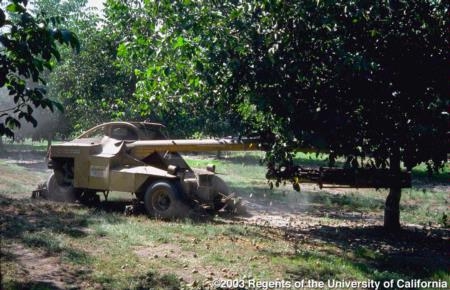Harvest time in California is almost a year-round affair in one area or another: winter lettuce and spinach in Salinas, early spring strawberries along the South Coast, summer squashes, herbs, and tomatoes galore, hays and grains as long as the dry season lasts, and countless other food and fiber crops through the year.
Like grapes, walnuts, apples and olives, the almonds get their turn in autumn. On the right day, you can watch as a Rube Goldberg-like machine rolls through a local nut orchard, grabbing hold of tree trunks one by one and shaking them so hard it'll rattle your bones, but just hard enough to knock loose practically every nut on the tree without damaging its trunk. A sweeper follows next, gathering up nuts in their rough hulls from the clean orchard floor, blowing them clean of debris, and dumping them into harvest bins. Simple as that. But 60 or 70 years ago this work was all done by hand, and the harvest that's now completed in a day could take a week or more.
First the farmers would clean the orchard floor and spread a big canvas sheet under a tree, wide enough to catch anything that could fall from its canopy. One or more members of the harvest crew then took up long, slender poles and knocked loose the harvest-ready nuts, still in their hulls. Nuts rained dusty onto the workers' wide-brimmed hats and the wide-spread sheet. A skilled harvester could work the long, willowy pole with a fly fisherman's skill to strike the last few stick-tight nuts, one by one, and down they'd fall. Each nut meant another ounce or so, which added up to pounds and eventually dollars from the buyer or co-op. Then as now, you don't do this sort of thing just for your health.
Nuts from the sheet were raked and shoveled onto a sled and dragged out of the orchard. While the harvest crew set to work on the next tree, others would pick debris out of the sled, scoop the cleaned nuts into big burlap sacks, stitch them shut, and load them onto a wagon for a trip to the railroad and on to market.
Old times and new. This year, California's largest almond-growing cooperative, Blue Diamond Growers, celebrates its 100th anniversary. You can learn more about the crop's history in California at a special centennial website.
Attached Images:
